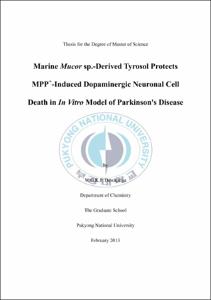Marine Mucor sp.-Derived Tyrosol Protects MPP+-Induced Dopaminergic Neuronal Cell Death in In Vitro Model of Parkinson's Disease
- Alternative Title
- MPP+에 의한 도파민성 신경세포의 사멸기작을 통한 해양 미생물 Mucor sp. 유래 Tyrosol의 파킨슨병 억제효과
- Abstract
- Marine-derived fungi have gained growing attention as a rich source of biologically active secondary metabolites. The bioactivity guided purification of ethyl acetate extract of marine-derived Mucor sp., isolated from surface of a marine red algae, yielded tyrosol [4-(2-hydroxyethyl)phenol] and tryptophol [2-(1H-Indol-3-yl)ethanol] as major secondary metabolites. The structure of the compounds was established on the basis of nuclear magnetic resonance (NMR) and mass spectroscopic data. Tyrosol production of the isolated Mucor sp. was sensitive for culture conditions and optimum culture conditions for production of tyrosol were identified. The protective role of tyrosol on 1-methyl-4-phenylpyridinium (MPP+)-induced dopaminergic neuronal cell [CATH.a and pheochromocytoma (PC-12)] death and activation of BV-2 murine microglia cells were assessed. Tyrosol significantly protected MPP+-induced CATH.a cell death and apoptosis in dose and time-dependant manner. MPP+-induced morphological changes in differentiated PC-12 cells were considerably attenuated by tyrosol treatment. Further, the compound repressed MPP+-induced depletion of mitochondrial membrane potential (∆ψm), intracellular ATP production and apoptotic signalling cascade in CATH.a cells. The molecular signalling pathway studies revealed that tyrosol protected neuron cells via activation of PI3K/Akt signalling pathway along with upregulation of anti-oxidative enzymes (superoxide dismutases; SOD1, SOD2) and DJ-1/PARK7 activity of the cell. Moreover, tyrosol significantly inhibited the production of reactive oxygen species (ROS), nitric oxide (NO) and inflammatory cytokine TNF-α in lipopolysaccharide (LPS)-induced BV-2 cells by inhibiting the nuclear translocation of nuclear factor-κB p50 and p65 subunits. The anti-inflammatory activity of tyrosol reinforced the protective effect of tyrosol on neuronal apoptosis. Collectively, results demonstrated that tyrosol protected dopaminergic neuronal degradation via both neuroprotection and anti-inflammation.
- Issued Date
- 2013
- Awarded Date
- 2013. 2
- Type
- Dissertation
- Publisher
- 부경대학교
- Affiliation
- 부경대학교 대학원
- Department
- 대학원 화학과
- Advisor
- 김세권
- Table Of Contents
- Table of Contents
Abstract………………………………………………………………………………….
Table of Contents………………………………………………………….....................
List of Tables……………………………………………………………........................
List of Figures…………………………………………………………………………...
List of Abbreviations…………………………………………………………………... i
ii
v
vi
ix
1. Introduction………………………………………………………………………. 1
1.1 Marine natural products…………………………………………………… 1
1.2 Marine-derived fungi……………………………………………………… 3
1.3 Biologically active metabolites of marine-derived fungi………………...... 7
1.4 Parkinson’s disease; aetiology, pathogenesis and therapeutic interventions………………………………………………………………..
8
1.5 Mitochondrial dysfunction in PD and therapeutic potentials……………… 11
1.6 Experimental models of Parkinson’s disease……………………………… 13
1.7 Role of inflammation in Parkinson’s disease……………………………… 15
2. Materials and methods…………………………………………………………... 17
2.1 Materials…………………………………………………………………… 17
2.2 Culturing, morphological examination and identification of the fungal strain……………………………………………………………………......
17
2.3 Extraction of secondary metabolites and structure elucidation of compounds…………………………………………………………………
18
2.4 Optimization of culture conditions for production of tyrosol……………... 19
2.5 Cell culture………………………………………………………………… 19
2.6 Determination of cytotoxicity……………………………………………... 19
2.7 Measurement of intracellular ROS formation……………………………... 21
2.8 Nitric oxide (NO) production assay……………………………………….. 22
2.9 Differentiation of PC-12 cells……………………………………………... 22
2.10 Flow cytometric analysis of cellular apoptosis……………………………. 23
2.11 Determination of mitochondrial membrane potential (∆ψm)……………… 23
2.12 Determination of intracellular ATP level………………………………….. 24
2.13 Immunostaining……………………………………………………………. 24
2.14 Semi-quantitative reverse transcriptase polymerase chain reaction (RT-PCR)………………………………………………………………………..
25
2.15 Western blot analysis……………………………………………………… 25
2.16 Statistical analysis…………………………………………………………. 27
3. Results…………………………………………………………………………….. 28
3.1 Morphological examination of the strain………………………………….. 28
3.2 Sequencing and alignment of the nucleotide sequence……………………. 28
3.3 Fractionation of ethyl acetate extract of the culture broth………………… 32
3.4 Structure elucidation of isolated compounds……………………………… 32
3.5 Effect of culture conditions for the production of tyrosol form isolated Mucor sp……………………………………………………………………
47
3.6 Cytocompatability of tyrosol………………………………………………. 47
3.7 Effect of MPP+ on viability of CATH.a cells……………………………... 50
3.8 Protective effect of tyrosol on MPP+-induced cytotoxicity……………….. 50
3.9 Protective effect of tyrosol on MPP+-induced apoptosis of CATH.a cell.… 53
3.10 Protective effect of tyrosol on MPP+-impaired mitochondrial membrane potential (∆ψm)……………………………………………………………..
53
3.11 Tyrosol attenuated MPP+-induced depletion of intracellular ATP level….. 57
3.12 Protective effect of tyrosol on MPP+-induced changes in neuronal morphology of differentiated PC-12 cells………………………………….
57
3.13 Tyrosol attenuated MPP+-induced ROS and NO production in CATH.a cells………………………………………………………………………...
60
3.14 Effect of tyrosol on anti-oxidative protein expression…….………………. 60
3.15 Effect of tyrosol on anti-apoptotic signalling molecules………………….. 63
3.16 Anti-inflammatory activity of tyrosol……………………………………... 67
3.17 Tyrosol protected CATH.a cell apoptosis induced by activated BV-2 cells 71
4. Discussion…………………………………………………………………………. 73
Summary………………………………………………………………………….. 79
References………………………………………………………………………… 81
- Degree
- Master
- Files in This Item:
-
-
Download
 Marine Mucor sp.-Derived Tyrosol Protects MPP+-Induced Dopaminergic Neuronal Cell Death in In Vitro .pdf
기타 데이터 / 6.84 MB / Adobe PDF
Marine Mucor sp.-Derived Tyrosol Protects MPP+-Induced Dopaminergic Neuronal Cell Death in In Vitro .pdf
기타 데이터 / 6.84 MB / Adobe PDF
-
Items in Repository are protected by copyright, with all rights reserved, unless otherwise indicated.